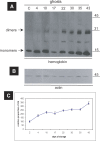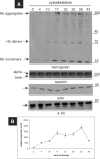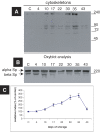Progressive oxidation of cytoskeletal proteins and accumulation of denatured hemoglobin in stored red cells
- PMID: 17367509
- PMCID: PMC4401228
- DOI: 10.1111/j.1582-4934.2007.00008.x
Progressive oxidation of cytoskeletal proteins and accumulation of denatured hemoglobin in stored red cells
Abstract
Red blood cell (RBC) membrane proteins undergo progressive pathological alterations during storage. In conditions of increased cellular stress, the cytoskeleton also sustains certain modifications. The hemoglobin (Hb) content and oxidative status of the RBC cytoskeletons as a function of the storage period remain unclear. The possible Hb content and oxidative alterations occurring in the cytoskeletons in the course of storage were monitored in six units, by means of electrophoresis, immunoblotting and protein carbonylation assays. A proportion of the ghost-bound Hb consists of non-reducible crosslinkings of probably oxidized(denatured Hb or hemichromes. The defective Hb-membrane association was strongly affected by the prolonged storage. A progressive accumulation of Hb monomers, multimers and high molecular weight aggregates to corresponding cytoskeletons were also evident. The oxidative index of the cytoskeletal proteins was found increased, signalizing oxidative modifications in spectrin and possibly other cytoskeletal proteins. The reported data corroborate the evidence for oxidative damage in membrane proteins with emphasis to the cytoskeletal components. They partially address the pathophysiological mechanisms underlying the RBC storage lesion, add some new insight in the field of RBC storage as a hemoglobin- and cytoskeleton-associated pathology and suggest the possible use of antioxidants in the units intended for transfusion.
Figures



Similar articles
-
Red blood cell aging markers during storage in citrate-phosphate-dextrose-saline-adenine-glucose-mannitol.Transfusion. 2010 Feb;50(2):376-89. doi: 10.1111/j.1537-2995.2009.02449.x. Epub 2009 Oct 23. Transfusion. 2010. PMID: 19874562
-
Membrane protein carbonylation in non-leukodepleted CPDA-preserved red blood cells.Blood Cells Mol Dis. 2006 Mar-Apr;36(2):279-82. doi: 10.1016/j.bcmd.2006.01.003. Epub 2006 Feb 28. Blood Cells Mol Dis. 2006. PMID: 16504550
-
Glutamine- and phosphate-containing hypotonic storage media better maintain erythrocyte membrane physical properties.Blood. 1996 Jul 15;88(2):697-704. Blood. 1996. PMID: 8695818
-
Biopreservation of red blood cells--the struggle with hemoglobin oxidation.FEBS J. 2010 Jan;277(2):343-56. doi: 10.1111/j.1742-4658.2009.07472.x. Epub 2009 Nov 26. FEBS J. 2010. PMID: 19968714 Review.
-
Red blood cells intended for transfusion: quality criteria revisited.Transfusion. 2006 Jan;46(1):137-42. doi: 10.1111/j.1537-2995.2006.00681.x. Transfusion. 2006. PMID: 16398743 Review.
Cited by
-
l-carnitine as a Potential Additive in Blood Storage Solutions: A Study on Erythrocytes.Indian J Hematol Blood Transfus. 2016 Sep;32(3):328-34. doi: 10.1007/s12288-015-0569-3. Epub 2015 Jul 11. Indian J Hematol Blood Transfus. 2016. PMID: 27429526 Free PMC article.
-
Benefits of hypoxic storage of red blood cells.Blood Transfus. 2023 Jan;21(1):1-2. doi: 10.2450/2023.0229-22. Blood Transfus. 2023. PMID: 36763908 Free PMC article. No abstract available.
-
Red Blood Cell Deformability Is Expressed by a Set of Interrelated Membrane Proteins.Int J Mol Sci. 2023 Aug 13;24(16):12755. doi: 10.3390/ijms241612755. Int J Mol Sci. 2023. PMID: 37628935 Free PMC article.
-
Red Blood Cell Metabolism In Vivo and In Vitro.Metabolites. 2023 Jun 27;13(7):793. doi: 10.3390/metabo13070793. Metabolites. 2023. PMID: 37512500 Free PMC article. Review.
-
Metabolic Linkage and Correlations to Storage Capacity in Erythrocytes from Glucose 6-Phosphate Dehydrogenase-Deficient Donors.Front Med (Lausanne). 2018 Jan 11;4:248. doi: 10.3389/fmed.2017.00248. eCollection 2017. Front Med (Lausanne). 2018. PMID: 29376053 Free PMC article.
References
-
- Yu J, Fischman DA, Steck TL. Selective solubilization of proteins and phospholipids from red blood cell membranes by non-ionic detergents. J Supramol Struct. 1973;1:233–48. - PubMed
-
- Liu S-C, Derick LH. Molecular anatomy of the red blood cell membrane skeleton: structure-function relationships. Semin Hematol. 1992;29:231–43. - PubMed
-
- Ho J, Sibbald WJ, Chin-Yee IH. Effects of storage on efficacy of red cell transfusion: when is it not safe? Crit Care Med. 2003;31:S687–97. - PubMed
-
- Bessos H, Seghatchian J. Red cell storage lesion: the potential impact of storage-induced CD47 decline on immunomodulation and the survival of leucofiltered red cells. Trans Aph Sci. 2005;32:227–32. - PubMed
-
- Stewart A, Urbaniak S, Turner M, Bessos H. The application of a new quantitative assay for the monitoring of intefrin-associated protein CD47 on red blood cells during storage and comparison with the expression of CD47 and phosphatidylserine with flow cytometry. Transfusion. 2005;45:1496–503. - PubMed
Publication types
MeSH terms
Substances
LinkOut - more resources
Full Text Sources
Other Literature Sources
Medical

